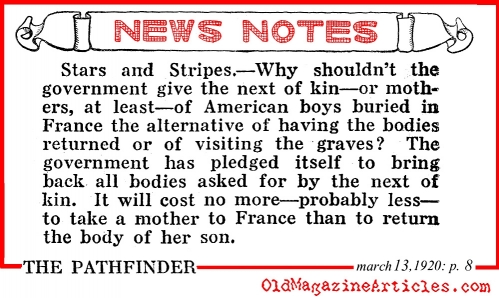Aside from scanning and posting vast numbers of historic magazine articles, the only other activity that has heightened our sense of inner tranquility has been our various walks through British and Commonwealth World War I graveyards. They are truly unique and beautiful gardens that can be appreciated on a number of different levels and it was not surprising to learn that many of the finest aesthetic minds in Britain had a hand in their creation.
This article, printed six months after the last shot was fired, is about the Imperial War Graves Commission (now called The Commonwealth War Graves Commission) and their plans as to how the dead of the British Empire were to be interred.
Click here to read about a 1920 visit the grave of poet Rupert Brooke.
"This chill November morning the Cenotaph is surrounded by serried masses of men. Up and down Whitehall as far as one can see are thousands and thousands packed in so tightly they cannot move...Suddenly from St. James Park comes the sound of a gun. They used to say it was impossible for a British crowd to be quiet. That was before Armistice Day. For the hum of London dies at the sound of the gun...Somewhere in the distance a horse paws the ground and neighs. A flag flaps in the breeze. Never such a silence as this. A King and his people pause sixty seconds in solemn celebration for the dead. It is the Great Hush." Eighteen years after the last shot was fired in World War I, Americans collectively wondered, as they began to think about all the empty chairs that were setting at so many family dinner tables, "Do the French care about all that we sacrificed? Do they still remember that we were there?" In response to this question, an American veteran who remained behind in France, submitted the attached article to "The American Legion Monthly" and answered with a resounding "Yes" on all six pages: "...I can assure you that the real France, the France of a thousand and one villages in which we were billeted; the France of Lorraine peasants, of Picardy craftsmen, of Burgundy winegrowers - remembers, with gratitude, the A.E.F. and its contribution to the Allied victory." The article is accompanied by eight photographs of assembled Frenchmen decorating American grave sites.
Click here to read about the foreign-born soldiers who served in the American Army of the First World War. 

|
Attached are some of moving observations penned by the Editor of The Independent, Hamilton Holt (1871 - 1951) when he toured Seicheprey, Cantigny, Chateau Thierry, St Mihiel and the Argonne battle fields -- which were the five battlefields where General Pershing chose to launch operations in the European war against Imperial Germany. There is one winsome photograph of the Aisne-Marne Cemetery as it appeared shortly after the conflict.
- from Amazon:

Within a year Holt would change his mind about the war as well as the treaty signed at Versailles.
A printable piece from a 1945 Collier's Magazine outlining how Sergeant Edward F. Younger (died August 6, 1942) selected which of the four unidentified Doughboys set before him would be interred in the Tomb of the Unknowns in Arlington Cemetery.
|